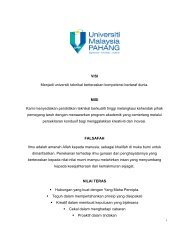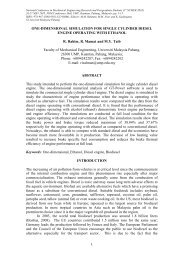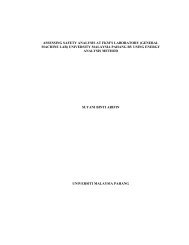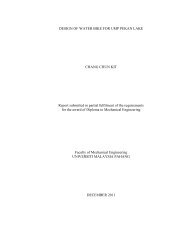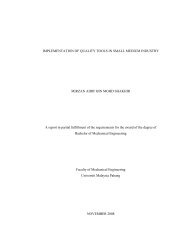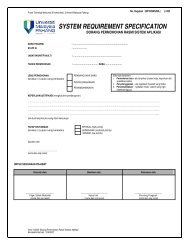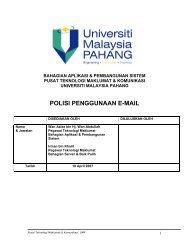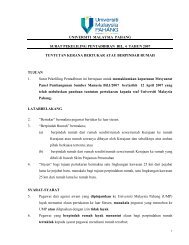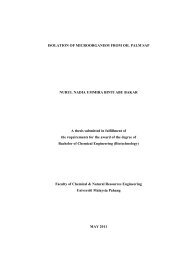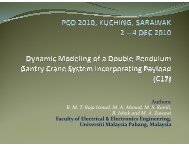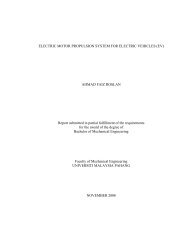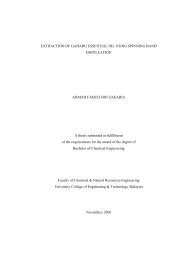design and simulation on the air dam for proton persona by using ...
design and simulation on the air dam for proton persona by using ...
design and simulation on the air dam for proton persona by using ...
Create successful ePaper yourself
Turn your PDF publications into a flip-book with our unique Google optimized e-Paper software.
SUPERVISOR DECLARATIONWe here<strong>by</strong> declare that we have read this <strong>the</strong>sis <str<strong>on</strong>g>and</str<strong>on</strong>g> in our opini<strong>on</strong> this <strong>the</strong>sis issufficient in terms of scope <str<strong>on</strong>g>and</str<strong>on</strong>g> quality <strong>for</strong> <strong>the</strong> award of <strong>the</strong> degree of Bachelor ofMechanical Engineering.Signature :....................................................Supervisor : GAN LEONG MINGPositi<strong>on</strong>: LECTURERDate:…………………………………Signature :....................................................Panel: MOHD YUSOF BIN TAIBPositi<strong>on</strong>: LECTURERDate :....................................................
ÏØ ´½½µ¸ ´½¿µ Ò ´½µ¸ Ø ÐØ Ò × Ó ´µ × ÖÐÝ ÓÑÔÙØÄ ´¾µ ½ÆÕÙØÒ ´½µ Ò ´½µ ØÖÑÒ×È ´ · · µ ½Æ¿ ´ · µ ¾ ´½µ ´ µ ¾ ½ Æ ´½µ¾´ · µÈÖÓÒ Ò ×ÑÐÖ ×ÓÒ ÛØ ´µ Ð× ØÓ Ø ÜÔÐØ ÓÖÑ Ó ´¿µ º ÓÖ ÜÑÔи ÓÖ Æ ¿Û Ú ´¿µ ½¾¿ ÜÔ´ ½ · ¾ · ¿ µ ½¾¿ ÜÔ ´ ½ · ¾ · ¿ µÜ ´ ½ · ¾ · ¿ µØ ·´Æ ½ · Æ ¾ · Æ ¿ µ℄ ´½µÛØ ½¾¿ ½¾ ½¿ ¾¿ ´ ½ ¾ µ ¾ ´ ½ ¿ µ ¾ ´ ¾ ¿ µ ¾´ ½ · ¾ µ ¾ ´ ½ · ¿ µ ¾ ´ ¾ · ¿ µ ¾ ´½µÆÓØ ØØ ´¿µ × ÒÓ ØÖÑ× Ò ¾ ÛØ ½Æ ÓÖ Æ ¿ ÓÒ Ò Ð×Ó ×ÓÛØØ ´Òµ ¼ ÓÖ Ò¿ Ò ØÖÓÖ Ø ÜÔÒ×ÓÒ Ò ´µ ØÖÙÒØ× ½·ÜÔ ½·ÜÔ ¾·ÜÔ ¿ ´¾¼µ· ½¾ ÜÔ´ ½· ¾ µ· ½¿ ÜÔ´ ½· ¿ µ· ¾¿ ÜÔ´ ¾· ¿ µ ´¾½µ· ½¾¿ ÜÔ´ ½· ¾· ¿ µÛØ ¯ ½º ÍÔÓÒ ×Ù×ØØÙØÓÒ Ó ´¾¼µ ÒØÓ ´¾µ Ø ÛÐйÒÓÛÒ ØÖ ×ÓÐØÓÒ ×ÓÐÙØÓÒ Ó Ø ÃÎÕÙØÓÒ ÓÐÐÓÛ׺ Ì Æ¹×ÓÐØÓÒ ×ÓÐÙØÓÒ ÓÖ ÒÝ Æ ¿ Ò ÓÒ×ØÖÙØ Ò ×ÑÐÖ Ûݺ¿º ÜÑÔÐ Ì ×Ö ÕÙØÓÒ ÛØ ÓÒÚØÓÒÏ ÔÔÐÝ Ø ÑØÓ Ò ËØÓÒ ¾ ØÓ Ø ×Ö ÕÙØÓÒ ÛØ ÓÒÚØÓÒ ØÖÑ ¾℄¸Ù Ø · ÙÙ Ü Ù ÜÜ Ù´½ Ùµ ¼´¾¾µÛ ×Ö× Ø ÔÖÓÔØÓÒ Ó ÒÖÚ ÔÙÐ×׺ ÈÒÐÚ ÒÐÝ×× ´× ËØÓÒ µ ÖÚÐ× ØØÙ´Ü Øµ ¾ ÐÒ ´Ü ص ܾ ´Ü µ´¾¿µØÖÒ×ÓÖÑ× ´¾¾µ ÒØÓ Ø ÕÙÖØ ÕÙØÓÒÆ ´ µ ´ ÜÜÜ · Ü ÜØ µ· Ü´ Ø ÜÜ · ¾ ܵ¼´¾µ¿
iiSTUDENT DECLARATIONI declare that this <strong>the</strong>sis entitled Design <str<strong>on</strong>g>and</str<strong>on</strong>g> Simulati<strong>on</strong> <strong>on</strong> <strong>the</strong> Air Dam <strong>for</strong> Prot<strong>on</strong>Pers<strong>on</strong>a <strong>by</strong> Using CFD Tool is <strong>the</strong> result of my own research except as cited inreferences. The <strong>the</strong>sis has not been accepted <strong>for</strong> any degree is not c<strong>on</strong>currentlysubmitted in c<str<strong>on</strong>g>and</str<strong>on</strong>g>idature <strong>for</strong> any o<strong>the</strong>r degree.Signature :………………………….Name : AHMAD SAPUAN BIN HASANDate : 10 NOVEMBER 2008
iiiDedicated to my belovedMo<strong>the</strong>r,Sisters,Bro<strong>the</strong>rs,Friends <str<strong>on</strong>g>and</str<strong>on</strong>g>My Fa<strong>the</strong>r
ivACKNOWLEDGEMENTThis <strong>the</strong>sis is <strong>the</strong> end of my l<strong>on</strong>g journey in obtaining my degree inMechanical Engineering with Automotive. I have not travelled in a vacuum in thisjourney. There are some people who made this journey easier with words ofencouragement <str<strong>on</strong>g>and</str<strong>on</strong>g> more intellectually satisfying <strong>by</strong> offering different places to lookto exp<str<strong>on</strong>g>and</str<strong>on</strong>g> my <strong>the</strong>ories <str<strong>on</strong>g>and</str<strong>on</strong>g> ideas. I would also like to gratefully acknowledge <strong>the</strong>support of some very special individuals. They helped me immensely <strong>by</strong> giving meencouragement <str<strong>on</strong>g>and</str<strong>on</strong>g> friendship.First a very special thanks you to Mr. Gan Le<strong>on</strong>g Ming. Mr Gan Le<strong>on</strong>g Minggave me <strong>the</strong> c<strong>on</strong>fidence <str<strong>on</strong>g>and</str<strong>on</strong>g> support to begin my degree in my Final Year Project.Mr. Gan challenged me to set my benchmark even higher <str<strong>on</strong>g>and</str<strong>on</strong>g> to look <strong>for</strong> soluti<strong>on</strong>s toproblems ra<strong>the</strong>r than focus <strong>on</strong> <strong>the</strong> problem. I learned to believe in my future my work<str<strong>on</strong>g>and</str<strong>on</strong>g> myself.Lastly but not least, my sincere gratitude to Mr. Mohd Fazli Bin Ismail <str<strong>on</strong>g>and</str<strong>on</strong>g>Mr. Faizul Bin Rajuli <strong>for</strong> <strong>the</strong>ir c<strong>on</strong>cern of my project progress <str<strong>on</strong>g>and</str<strong>on</strong>g> always be <strong>the</strong>rewhen I need <strong>the</strong>ir helps. Also to o<strong>the</strong>r lecturers <str<strong>on</strong>g>and</str<strong>on</strong>g> technician who had directly <str<strong>on</strong>g>and</str<strong>on</strong>g>indirectly c<strong>on</strong>tributed in c<strong>on</strong>tributed in completing this project.
vABSTRACTThis project was carried out to <str<strong>on</strong>g>design</str<strong>on</strong>g> aerodynamic <str<strong>on</strong>g>and</str<strong>on</strong>g> efficient fr<strong>on</strong>t <strong>air</strong> <strong>dam</strong><strong>for</strong> Prot<strong>on</strong> Pers<strong>on</strong>a car. In carrying this project, <strong>the</strong> objective is to compare <strong>the</strong> carstability <strong>for</strong> Prot<strong>on</strong> Pers<strong>on</strong>a car with <str<strong>on</strong>g>and</str<strong>on</strong>g> without <strong>air</strong> <strong>dam</strong>. The whole process willinvolve <str<strong>on</strong>g>design</str<strong>on</strong>g>ing, matching, <str<strong>on</strong>g>simulati<strong>on</strong></str<strong>on</strong>g> approach <str<strong>on</strong>g>and</str<strong>on</strong>g> comparis<strong>on</strong> <strong>the</strong> data. Airflowaround vehicle can affect many aspects of vehicle per<strong>for</strong>mance including vehicledrag, vehicle lift <str<strong>on</strong>g>and</str<strong>on</strong>g> down <strong>for</strong>ce. Vehicle lift <str<strong>on</strong>g>and</str<strong>on</strong>g> down <strong>for</strong>ce can affect <strong>the</strong> vehiclestability <str<strong>on</strong>g>and</str<strong>on</strong>g> h<str<strong>on</strong>g>and</str<strong>on</strong>g>ling. This <strong>air</strong> <strong>dam</strong> was <str<strong>on</strong>g>design</str<strong>on</strong>g> to reduce lift <strong>for</strong>ce <str<strong>on</strong>g>and</str<strong>on</strong>g> improve <strong>the</strong>turbulent <strong>air</strong> flow underneath Prot<strong>on</strong> Pers<strong>on</strong>a car. The <str<strong>on</strong>g>design</str<strong>on</strong>g> is refer to <strong>the</strong> marketjournal <str<strong>on</strong>g>and</str<strong>on</strong>g> market also. The dimensi<strong>on</strong> gets from <strong>the</strong> model vehicle scanning <strong>by</strong> 3DScanner. Than sketch <strong>the</strong> base line of <strong>air</strong> <strong>dam</strong> in Solidwork. Besides that, prepare <strong>the</strong>model vehicle in software envir<strong>on</strong>ments <strong>for</strong> <str<strong>on</strong>g>simulati<strong>on</strong></str<strong>on</strong>g> process. This <strong>the</strong>sis focus <strong>on</strong><str<strong>on</strong>g>design</str<strong>on</strong>g> of <strong>air</strong> <strong>dam</strong> <str<strong>on</strong>g>and</str<strong>on</strong>g> how it will affect to <strong>the</strong> underbody flow. The <str<strong>on</strong>g>simulati<strong>on</strong></str<strong>on</strong>g> iscomparing <strong>the</strong> vehicle model with <str<strong>on</strong>g>and</str<strong>on</strong>g> without <strong>air</strong> <strong>dam</strong> base pressure distributi<strong>on</strong>.The result will be compare <strong>on</strong> pressure distributi<strong>on</strong> underbody. The <strong>air</strong> <strong>dam</strong> willaffect <strong>the</strong> lift <strong>for</strong>ce <strong>on</strong> <strong>the</strong> fr<strong>on</strong>t Prot<strong>on</strong> Pers<strong>on</strong>a when moving in high speed.However, <strong>the</strong> height of <strong>air</strong> <strong>dam</strong> must suitable with road requirement to avoid <strong>dam</strong>ageto <strong>air</strong> <strong>dam</strong> when driving in rough road surface.
viABSTRAKProjek ini adalah bertujuan untuk mencorak penhadang udara yangaerodinamik dan cekap untuk kereta Prot<strong>on</strong> Pers<strong>on</strong>a. Dalam menjayakan projek ini,objektifnya adalah memb<str<strong>on</strong>g>and</str<strong>on</strong>g>ingkan kestabilan untuk kereta Prot<strong>on</strong> Pers<strong>on</strong>a denganmemasang penhadang udara dan tanpa penhadang udara. Keseluruhan proses akanmelibatkan reka bentuk penhadang udara, pasang, pendekatan simulasi danperb<str<strong>on</strong>g>and</str<strong>on</strong>g>ingan data. Aliran udara sekitar kenderaan boleh menjejaskan banyak aspekprestasi kenderaan termasuk seretan kenderaan, daya tujah ke atas pada bahagi<str<strong>on</strong>g>and</str<strong>on</strong>g>epan kenderaan dan daya kebawah. Daya angkat kenderaan dan daya kebawahboleh menjejaskan kestabilan kenderaan dan pem<str<strong>on</strong>g>and</str<strong>on</strong>g>uan. Penhadang udara ini adalahreka bentuk untuk mengurangkan daya angkat dan memperbaiki aliran udara yangtidak berpusar di bawah kereta Prot<strong>on</strong> Pers<strong>on</strong>a. Reka bentuk ialah merujuk jurnaluntuk pasaran dan pasaran juga. Dimensi diperoleh daripada pengimbasan kenderaanoleh 3D Scanner. Selepas itu lakaran gambaran asas penhadang udara dilukis dalamSolidwork. Selain yang, menyediakan kenderaan misali dalam persekitaran perisianuntuk proses simulasi. Tumpuan tesis ini adalah kepada reka bentuk penhadangudara dan bagaimana ia akan menjejaskan untuk bawah kereta aliran. Simulasiadalah memb<str<strong>on</strong>g>and</str<strong>on</strong>g>ingkan kenderaan dengan penhadang dan tanpa penhadang udarataburan tekanan asas. Hasil akan menjadi perb<str<strong>on</strong>g>and</str<strong>on</strong>g>ingan di taburan tekanan bawahbadan. Empangan udara akan menjejaskan daya angkat di muka Prot<strong>on</strong> Pers<strong>on</strong>aapabila masuk kelajuan tinggi. Bagaimanapun, ketinggian empangan udara perlusesuai dengan jalan keperluan bagi mengelakkan kerosakan untuk empangan udaraapabila mem<str<strong>on</strong>g>and</str<strong>on</strong>g>u di permukaan jalan yang tidak rata.
viiTABLE OF CONTENTPAGEDECLARATIONDEDICATIONACKNOWLEDGMENTABSTRACTABSTRAKLIST OF TABLELIST OF FIGURELIST OF SYMBOLLIST OF ABBREVIATIONLIST OF APPENDIXiiiiiivvvixxixiixiiixivCHAPTER 1INTRODUCTION1.1 Background Project 11.2 Problem Statement 21.3 Project Objective 31.4 Scope of Project 31.5 Flow Chart of <strong>the</strong> Project 4CHAPTER 2LITERATURE REVIEW2.0 Introducti<strong>on</strong> 52.1 Vehicle Body Aerodynamic2.1.1 Venturi 72.1.2 Air Streamline 8
viii2.1.3 Drag Coefficient 92.1.4 Lift Coefficient 102.2 Aerodynamic Air Dam2.2.1 Underbody Dam 112.2.2 Stagnati<strong>on</strong> Point at Air Dam 112.2.3 Corner Vane 122.2.4 Air Splitter 132.2.5 Percentage Difference 142.3 Design Characteristic2.3.1 Basic Design 152.3.2 Air Dam with Three Canards 162.3.3 Air Dam with Nozzle 17CHAPTER 3METHODOLOGY3.1 Project Methodology 183.2 First stages: Literature Study 203.3 Sec<strong>on</strong>d Stage: Prepare 3D model of Prot<strong>on</strong> Pers<strong>on</strong>a 203.3.1 Combine <strong>the</strong> Subgroup 223.3.2 Change to IGES File 233.4 Third Stage: Design <str<strong>on</strong>g>and</str<strong>on</strong>g> Assemble 233.4.1 Design Characteristic 253.5 Fourth Stage: Analyzing Using CFD Simulati<strong>on</strong> 263.6 Fifth Stage: Analysis of Simulati<strong>on</strong> Result 273.6.1 Valid <strong>the</strong> Result 28CHAPTER 4RESULT AND DISCUSSION4.1 Result 294.2 Comparis<strong>on</strong> <strong>the</strong> Result With <str<strong>on</strong>g>and</str<strong>on</strong>g> Without Air Dam 304.2.1 Pressure Comparis<strong>on</strong> 304.2.2 Summary of Pressure Comparis<strong>on</strong> 324.2.3 Velocity Comparis<strong>on</strong> 334.2.4 Summary of Pressure Comparis<strong>on</strong> 35
ix4.2.5 Trajectories Pressure View 374.3 Data Collecti<strong>on</strong> 394.3.1 Summary of <strong>the</strong> Result 40CHAPTER 5CONCLUSION AND RECOMMENDATION5.1 C<strong>on</strong>clusi<strong>on</strong> 435.2 Recommendati<strong>on</strong> 44REFFERENCES 45Appendix A-J 47-56
xLIST OF TABLETABLE NO. TITLE PAGE3.1 Design Measurement 244.1 Result Pressure <str<strong>on</strong>g>and</str<strong>on</strong>g> Velocity <strong>for</strong> All Simulati<strong>on</strong> 404.2 Summary of <strong>the</strong> result finding 41
xiLIST OF FIGURESFIGURE NO. TITLE PAGES2.1 Comparis<strong>on</strong> of low <str<strong>on</strong>g>and</str<strong>on</strong>g> high aerodynamic drag <strong>for</strong>ceswith rolling resistance 62.2 Air flows through <strong>the</strong> venturi 72.3 Streamline <strong>air</strong> flow around car 82.4 Pressure distributi<strong>on</strong> above <str<strong>on</strong>g>and</str<strong>on</strong>g> below <strong>the</strong> body structure 92.5 Stagnati<strong>on</strong> point flow 112.6 Influence of corner vanes in reducing truck side panelflow separati<strong>on</strong> 122.7 Air Splitter affect to <strong>air</strong> flow 142.8 Basic <str<strong>on</strong>g>design</str<strong>on</strong>g> of <strong>air</strong> <strong>dam</strong> 152.9 Full Design Air Dam 162.10 Nozzle Shape in Both Side of Air Dam 173.1 Flow Chart of Methodology 193.2 Part of 3D Scanner 213.3 Ground clearance Prot<strong>on</strong> Pers<strong>on</strong>a 243.4 <strong>the</strong> complete model assemble 243.5 Design 1 253.6 Design 2 263.7 Design 3 263.8 C<strong>on</strong>diti<strong>on</strong> Domain 274.1 Design 1 compare with model without <strong>air</strong> <strong>dam</strong> 31
xii4.2 Design 2 compare with model without <strong>air</strong> <strong>dam</strong> 324.3 Design 3 compare with model without <strong>air</strong> <strong>dam</strong> 324.4 Design 1 compare with model with <strong>air</strong> <strong>dam</strong> 344.5 Design 2 compare with without <strong>air</strong> <strong>dam</strong> model 354.6 Design 3 compare with model without <strong>air</strong> <strong>dam</strong> 354.7 Trajectories pressure <str<strong>on</strong>g>design</str<strong>on</strong>g> 1 374.8 Trajectories pressure <str<strong>on</strong>g>design</str<strong>on</strong>g> 2 374.9 Trajectories pressure <str<strong>on</strong>g>design</str<strong>on</strong>g> 3 384.10 The result point taken 39
xiiiLIST OF SYMBOLSF LLift <strong>for</strong>ce (N)ρ Density (kg/m 3 )V Velocity (ms -1 )A Area (m 3 )PPressure (Pa)P Atmosphere pressure (Pa @ atm)C DDrag coefficientF DDrag <strong>for</strong>ce (N)lLength (m)% Percentage
xvLIST OF APPENDIXAPPENDIX TITLE PAGEA Project Gantt chart 47B Grill 1 48C Grill 2 40D Design 1 50E Design 2 51F Design 3 52G Model Vehicle Prot<strong>on</strong> Pers<strong>on</strong>a 53H Assemble 1 54I Assemble 2 55J Assemble 3 56
1CHAPTER 1INTRODUCTION1.0 Background of ProjectNow day, road vehicle tends to develop lift thrust <strong>on</strong> <strong>the</strong> body. Base <strong>on</strong> <strong>the</strong>Prot<strong>on</strong> Pers<strong>on</strong>a <str<strong>on</strong>g>design</str<strong>on</strong>g>, <strong>the</strong> upper aerodynamics shape will provide smooth to let <strong>air</strong>flow moving faster through <strong>the</strong> body. During high speed, pressure distributi<strong>on</strong> atupper <str<strong>on</strong>g>and</str<strong>on</strong>g> underneath vehicle is different. The lift <strong>for</strong>ce occur when <strong>air</strong> pressure atunderneath is greater than upper <strong>air</strong> pressure. It does depend to <strong>the</strong> velocity of <strong>air</strong>flow surround <strong>the</strong> vehicle. According to Bernoulli principle, when increase velocity<strong>the</strong> pressure will decrease <str<strong>on</strong>g>and</str<strong>on</strong>g> decrease velocity will increase pressure.This project will focus <strong>on</strong> study underneath <strong>air</strong> flow <strong>for</strong> Prot<strong>on</strong> Pers<strong>on</strong>a. An<strong>air</strong> <strong>dam</strong> was <str<strong>on</strong>g>design</str<strong>on</strong>g> to improve car per<strong>for</strong>mance <strong>by</strong> blocking <strong>air</strong> from to underneath<str<strong>on</strong>g>and</str<strong>on</strong>g> change <strong>the</strong> <strong>air</strong> directi<strong>on</strong> around <strong>the</strong> body. With proper <str<strong>on</strong>g>design</str<strong>on</strong>g> <strong>air</strong> <strong>dam</strong> willgenerate negative down <strong>for</strong>ce to <strong>the</strong> vehicle body. The <strong>air</strong> <strong>dam</strong>s create to fix liftthrust at <strong>the</strong> fr<strong>on</strong>t Prot<strong>on</strong> Pers<strong>on</strong>a <str<strong>on</strong>g>and</str<strong>on</strong>g> improve vehicle h<str<strong>on</strong>g>and</str<strong>on</strong>g>ling.
21.2 Problem StatementProt<strong>on</strong> Pers<strong>on</strong>a is <strong>the</strong> most successful model in Malaysia produce <strong>by</strong> Prot<strong>on</strong>.During moving in high speed, <strong>the</strong> vehicle tends to develop a partial vacuum <strong>on</strong> <strong>the</strong>upper c<strong>on</strong>toured surface relative to underside pressure (Tsutomu, 1980). The <strong>air</strong> flowsplits up into <strong>the</strong> upper stream which move over <strong>the</strong> upper surface of <strong>the</strong> vehicle <str<strong>on</strong>g>and</str<strong>on</strong>g><strong>the</strong> lower stream which moves below <strong>the</strong> bottom of <strong>the</strong> Prot<strong>on</strong> Pers<strong>on</strong>a. The velocityof <strong>the</strong> stream upper <str<strong>on</strong>g>and</str<strong>on</strong>g> below <strong>the</strong> Prot<strong>on</strong> Pers<strong>on</strong>a also difference. The result to <strong>the</strong>vehicle is having lift <strong>for</strong>ce or thrust upward. It will cause <strong>the</strong> fr<strong>on</strong>t tire lose grip to <strong>the</strong>ground <str<strong>on</strong>g>and</str<strong>on</strong>g> affect to stability of <strong>the</strong> vehicle. All of this will c<strong>on</strong>tribute to poor drivingper<strong>for</strong>mance.An <strong>air</strong> <strong>dam</strong> was <str<strong>on</strong>g>design</str<strong>on</strong>g> to c<strong>on</strong>trol <strong>the</strong> lift <strong>for</strong>ce at <strong>the</strong> fr<strong>on</strong>t Prot<strong>on</strong> Pers<strong>on</strong>a.However, <strong>the</strong>re is many type of <str<strong>on</strong>g>design</str<strong>on</strong>g> in <strong>the</strong> market. This project will come out <strong>the</strong><strong>air</strong> <strong>dam</strong> <str<strong>on</strong>g>design</str<strong>on</strong>g> that suitable <strong>for</strong> Prot<strong>on</strong> Pers<strong>on</strong>a <str<strong>on</strong>g>and</str<strong>on</strong>g> improve <strong>the</strong> aerodynamic flow.1.3 Project ObjectivesBasically <strong>the</strong> main purpose in accomplishing this task are stated belowi. Design <strong>the</strong> aerodynamics fr<strong>on</strong>t <strong>air</strong> <strong>dam</strong> <strong>for</strong> Prot<strong>on</strong> Pers<strong>on</strong>a.ii. Simulati<strong>on</strong> of aerodynamics <strong>for</strong> Prot<strong>on</strong> Pers<strong>on</strong>a with <str<strong>on</strong>g>and</str<strong>on</strong>g> without <strong>air</strong> <strong>dam</strong>.
31.4 Scopes of ProjectThe scope of this project is foc<strong>using</strong> <strong>on</strong> <strong>the</strong> criteria that stated belowa. Literature study <strong>on</strong> <strong>the</strong> vehicle <strong>air</strong> flow system.b. 3D scanning of <strong>the</strong> existing Prot<strong>on</strong> Pers<strong>on</strong>a.c. Design of <strong>air</strong> <strong>dam</strong> <strong>for</strong> Prot<strong>on</strong> Pers<strong>on</strong>a.d. Boundary c<strong>on</strong>diti<strong>on</strong> setting.e. Simulati<strong>on</strong> of <strong>air</strong> flow <strong>for</strong> new <str<strong>on</strong>g>design</str<strong>on</strong>g> of <strong>air</strong> <strong>dam</strong>.f. Analysis <strong>on</strong> <strong>the</strong> <str<strong>on</strong>g>simulati<strong>on</strong></str<strong>on</strong>g> result.g. Report preparati<strong>on</strong>.
41.5 Flow Chart of The ProjectSTARTLiterature Review3d Modeling of Studies VehicleC<strong>on</strong>versi<strong>on</strong> of 3d Car Model into Simulati<strong>on</strong>Envir<strong>on</strong>mentC<strong>on</strong>ceptual Design of Fr<strong>on</strong>t Air DamNoMatching WithVehicleYesBoundary C<strong>on</strong>diti<strong>on</strong> SettingAir Flow Simulati<strong>on</strong>NoAnalysisYesFinal <strong>the</strong>sis documentati<strong>on</strong>Final presentati<strong>on</strong>End
5CHAPTER 2LITERATURE REVIEW2.0 Introducti<strong>on</strong>The importance of aerodynamics to race car has been known through most of<strong>the</strong> sport history. By <strong>the</strong> early 1960, <strong>the</strong> speed of race car increase rapidly. Base <strong>on</strong><strong>on</strong>e lap record speed <strong>for</strong> <strong>the</strong> Indianapolis 500 (United State) has been above 80mph(129kph) since be<strong>for</strong>e 1920. In an attempt to decrease speed <str<strong>on</strong>g>and</str<strong>on</strong>g>, <strong>the</strong>re<strong>for</strong>e, increasesafety, regulati<strong>on</strong>s were enacted to limit engine power <str<strong>on</strong>g>and</str<strong>on</strong>g> tire size. Car <str<strong>on</strong>g>design</str<strong>on</strong>g>erswere <strong>for</strong>ced to look elsewhere to give <strong>the</strong>ir team an advantage. The advantage wasfound in aerodynamics. [Cislunar Aerospace Inc, 1997].Air <strong>dam</strong> is creating to deal with aerodynamics. Air <strong>dam</strong> is a device made ofmetal or plastic fitted beneath <strong>the</strong> fr<strong>on</strong>t bumper of an automobile <str<strong>on</strong>g>and</str<strong>on</strong>g> intended toenhance aerodynamics <str<strong>on</strong>g>and</str<strong>on</strong>g> stability <strong>by</strong> blocking <strong>the</strong> flow of turbulent <strong>air</strong> under <strong>the</strong>chassis refer to ‘The American Heritage® Dicti<strong>on</strong>ary of <strong>the</strong> English Language’:Fourth Editi<strong>on</strong> 2000. Air <strong>dam</strong> also applies <strong>for</strong> heavy vehicle such as lorry <str<strong>on</strong>g>and</str<strong>on</strong>g> truckto improve fuel efficient (Doug, 2005).In <strong>the</strong> world modern car <strong>the</strong> manufacturers focus <strong>on</strong> <strong>the</strong> aerodynamicsper<strong>for</strong>mance of <strong>the</strong> vehicle. The lift <str<strong>on</strong>g>and</str<strong>on</strong>g> drag <strong>for</strong>ces that act <strong>on</strong> <strong>the</strong> vehicle giveimpact to per<strong>for</strong>mance <str<strong>on</strong>g>and</str<strong>on</strong>g> body shape. The manufacturers attempt to c<strong>on</strong>trol <strong>the</strong>se<strong>for</strong>ces to maximize <strong>the</strong> vehicle per<strong>for</strong>mance. The manufacturers also aware importantof <strong>air</strong> <strong>dam</strong> c<strong>on</strong>tribute <strong>on</strong> <strong>the</strong> aerodynamics per<strong>for</strong>mance. Some new models launch<strong>air</strong> <strong>dam</strong> integrated with <strong>the</strong> fr<strong>on</strong>t bumper.
62.1 Vehicle Body AerodynamicsAerodynamics is <strong>the</strong> study of a solid body moving through <strong>the</strong> atmosphere<str<strong>on</strong>g>and</str<strong>on</strong>g> <strong>the</strong> interacti<strong>on</strong> which takes place between <strong>the</strong> body surfaces <str<strong>on</strong>g>and</str<strong>on</strong>g> <strong>the</strong> surrounding<strong>air</strong> with varying relative speeds <str<strong>on</strong>g>and</str<strong>on</strong>g> wind directi<strong>on</strong>s (Heinz, 2002). Aerodynamicsdrag is usually neglected at low vehicle speed but <strong>the</strong> magnitude of <strong>air</strong> resistancebecomes important with <strong>the</strong> rising speed. This can be seen in Figure 2.1 belowwhich compares <strong>the</strong> aerodynamics drag <strong>for</strong>ces of a weak streamlined <str<strong>on</strong>g>and</str<strong>on</strong>g> highlystreamlined <strong>for</strong> vehicle with difference velocity. A vehicle with high drag resistancetends to decelerati<strong>on</strong> <strong>the</strong> vehicle. When increase <strong>the</strong> speed, <strong>the</strong> fuel c<strong>on</strong>sumpti<strong>on</strong>efficiency is getting worst.Figure 2.1: Comparis<strong>on</strong> of low <str<strong>on</strong>g>and</str<strong>on</strong>g> high aerodynamic drag <strong>for</strong>ces with rollingResistance, (Heinz, 2002).
72.1.1 VenturiThe shape of surface also affects <strong>the</strong> aerodynamics drag. When <strong>air</strong> flowthrough a diverging <str<strong>on</strong>g>and</str<strong>on</strong>g> c<strong>on</strong>verging secti<strong>on</strong> of venturi <strong>the</strong> <strong>air</strong> pressure <str<strong>on</strong>g>and</str<strong>on</strong>g> speedchange show in Figure 2.2. Air molecules initially under atmospheric pressure, whenflow into small area <strong>the</strong> molecules are relatively close toge<strong>the</strong>r. It will increase <strong>the</strong>pressure <str<strong>on</strong>g>and</str<strong>on</strong>g> minimum <strong>the</strong> speed of <strong>air</strong> flow. The velocity of <strong>air</strong> flow acceleratewhen move into <strong>the</strong> c<strong>on</strong>verging area to maintain <strong>the</strong> volume flow (Heinz, 2002). At<strong>the</strong> middle of venture it produces high velocity <str<strong>on</strong>g>and</str<strong>on</strong>g> low pressure because of <strong>the</strong> crosssecti<strong>on</strong> area at <strong>the</strong> middle. The exit presents diverging area, where <strong>air</strong> flowdecelerates because <strong>the</strong> molecules are able to move freely. For vehicle shape <strong>the</strong>fr<strong>on</strong>t presents diverging <str<strong>on</strong>g>and</str<strong>on</strong>g> c<strong>on</strong>verging at <strong>the</strong> rear.Figure 2.2: Air flows through <strong>the</strong> venturi (Heinz, 2002)



